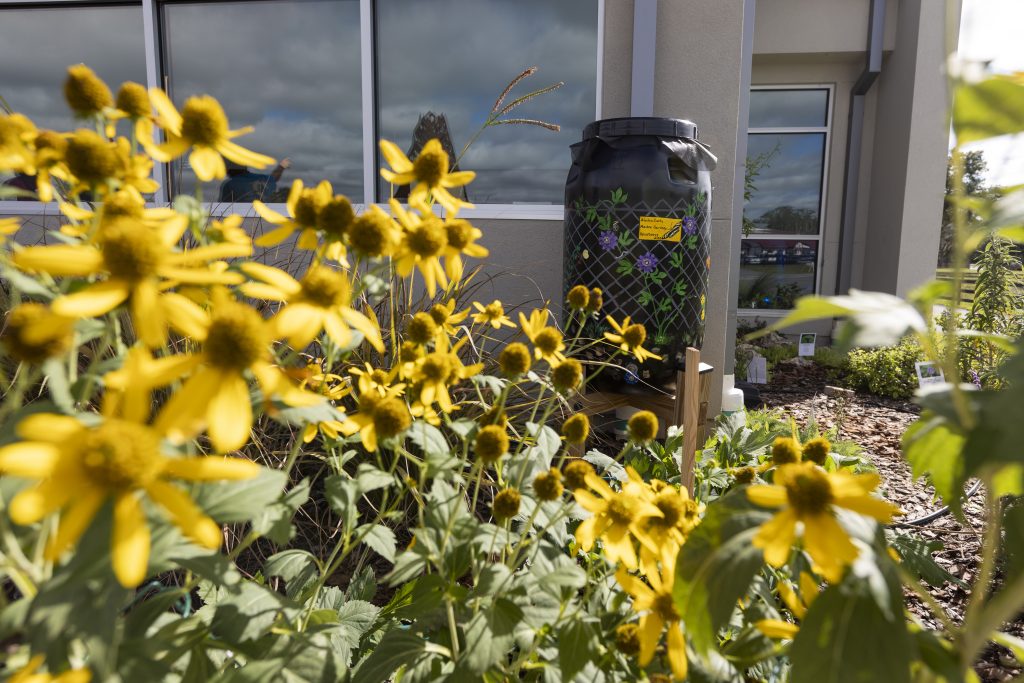
Water is one of the most valuable natural resources and with the ever growing concern of climate change and the hot dry conditions Northwest Florida has already experienced this summer, every drop counts. One way you could combat this issue is by installing a rain barrel at your home. By having a rain barrel on hand, you can reduce stormwater runoff, potentially save money, and improve the health of your plants. Here’s what you need to know:
What is a rain barrel? A rain barrel is a container or storage tank that collects runoff water from a catchment area (a rooftop). They are typically placed under downspouts and capture the water runoff from your home’s gutters. The type of container used to make a rain barrel could be any type, but it cannot have stored chemicals prior to its use as a rain barrel.
Now that we know the definition, why exactly do people use rain barrels? For one, they aid in water conservation. Rain barrels help reduce the amount of potable water used for outdoor purposes, which is important during dry weather spells and areas known for drought conditions. There are also potential cost savings with using a rain barrel. By using the collected rainwater for watering your garden, cleaning outdoor surfaces, or even washing your car, homeowners could potentially reduce their water bills significantly. Having a rain barrel is also a Florida-Friendly way to gardening. Rain barrel usage co-aligns with the Florida-Friendly Landscaping Principles #2: Water Efficiently and #8: Reduce Stormwater Runoff. The use of rain barrels also aligns with sustainable living. It reduces the reliance on municipal water systems and promotes awareness of water usage and conservation.
To install a rain barrel, you will need to obtain a container or “barrel” that is several gallons large to store the water. You can purchase or make one yourself! It will need a secure lid to prevent debris and insects from getting inside. The barrel will need to be placed under a downspout from your home’s roof gutter systems. The ground will need to be level and the barrel could possibly need to be elevated to make accessing the water easier. Once you have placed the rain barrel in the location you want it, you will need to install a rainwater diverter on your downspout. This will help channel the rainwater into the barrel and can be adjusted once the barrel has become full of water. You will also want to install a spigot near the bottom of the rain barrel to access the water and an overflow valve of some sort. The overflow valve will help redirect excess water away from your foundation when the rain barrel becomes full. Maintenance of a rain barrel is generally very low but you need to check regularly for debris in the water and ensure all the mechanisms are functioning like they should be.
How can you use the water collected in a rain barrel? The most obvious answer would be to water your garden and outdoor plants. Rainwater is perfect for watering the lawn, your flowers, and vegetable gardens. The water quality of collected rainwater is often more beneficial for plants as it is non-chlorinated water. Rainwater is also great for indoor plants too as it decreases the amount of mineral build-up that can occur from using tap water.
By installing a rain barrel at your home, you are taking a small leap with significant environmental impact. It is an easy, cost-effective way to reduce your utility bills, conserve water, and contribute to sustainable living. For more information on rain barrels and how to install one, please visit:
https://ffl.ifas.ufl.edu/ffl-and-you/home-landscapes/diy/rain-barrels/
https://sfyl.ifas.ufl.edu/lawn-and-garden/saving-and-using-rainwater/
*This article was written with the aid of ChatGPT AI Services.*
 1
1
